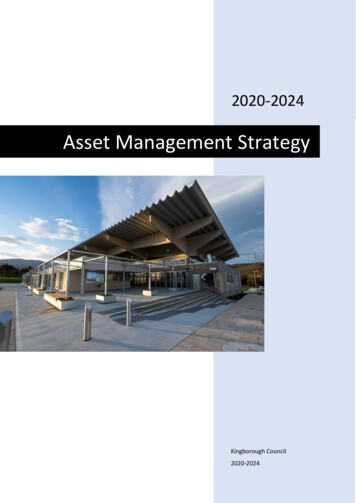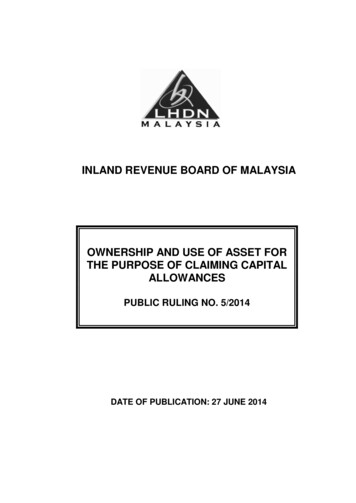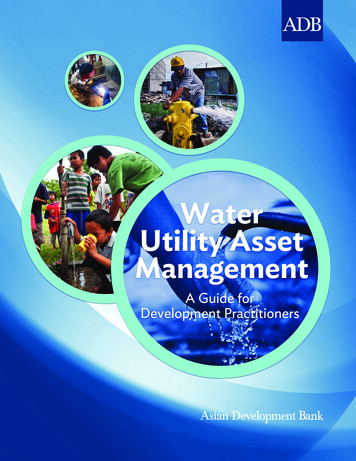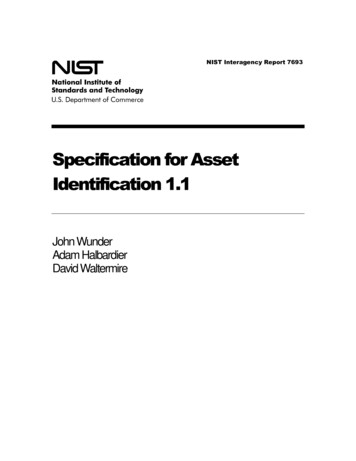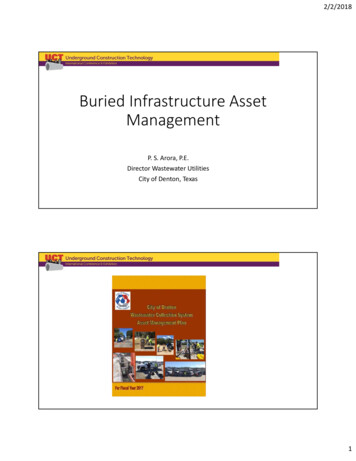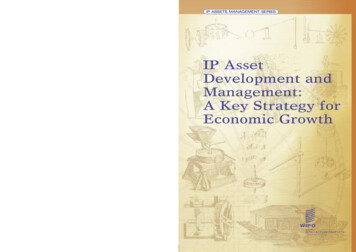
Transcription
IP ASSETS MANAGEMENT SERIESIP AssetDevelopment andManagement:A Key Strategy forEconomic GrowthFor more information contact WIPO at www.wipo.intWorld Intellectual Property Organization34, Chemin des ColombettesCase postale 18CH-1211 Geneva 20SwitzerlandTelephone: 41 22 338 91 11Fax: 41 22 733 54 28WIPO Publication No. 896EISBN 978-92-805-1562-6
52. lg.php?ID 2453. www.les.org54. www.ipacademy.edu.sg55. http://www.wipo.int/ebookshop?lang eng&cmd display pub&cat id 123056. www.ait.ac.th/57. www.nus.edu.sg58. http://web.mit.edu/org/c/ctpid/www/about.html59. http://www.law.northwestern.edu/llmkorea/60. See description of Dolby in “Intellectual Property, A Power Tool for Economic Growth”, p. 170and 171.61. Summary of 2004 AUTM Licensing Survey at http://www.ssti.org/Digest/Tables/112105t.htm62. See “From Tech Transfer to Joint Ventures” by Jack Granowitz, interviewed in “From Ideas toAssets” by Bruce Berman, Wiley Publishers, 2002; and the 2004 Annual Report for Science andTechnology Ventures at http://www.stv.columbia.edu/about/reports/63. WIPO Publication No. 903 http://www.wipo.int/ebookshop?lang eng&cmd display pub&catid 123064. See “Intellectual Property, A Power Tool for Economic Growth,” p. 165.65. See Douglas Elliott, “Asset Backed IP Financing,” in Berman, “From Ideas to Assets”.66. See Louis T. Wells and Alvin Wint, “Marketing a Country: Promotion as a Tool for AttractingForeign Investment,” Foreign Investment Advisory Service, Washington, D.C., 1990.67. See description of Tequila as a geographical indication in “Intellectual Property, a Power Toolfor Economic Growth”, p.181-182.68. “Intellectual Property Audit Tool”, WIPO Publication No.927E by IP and New TechnologiesDivision 41 22 338 8814Cover images courtesy of:Scientific American;Molinos Nuevos (Museo Hidraulica), Murcia, Spain;www.waterhistory.org;Dr Monzur Ahmed;Schiöler at Experimentarium, Denmark.
IP ASSETS MANAGEMENT SERIESIP AssetDevelopment andManagement:A Key Strategy forEconomic Growth1
2PREFACEIntellectual Property (IP) in the form of patents, trademarks, copyrightedworks, industrial designs, trade secrets, geographical indications, like othertypes of property, can be developed, owned, managed and commercializedto generate an economic return. Increasingly, private enterprises and academic institutions see patents, trademarks, copyrighted works and otherforms of IP as economic assets, the value of which can be optimized byproactive policies and strategies. At the governmental level, many MemberStates are seeking practical information on proactive policies and strategiesfor national and regional asset development.This booklet identifies and presents data concerning the key policies, strategies and practices that are effective in stimulating and supporting the development, accumulation, management and use of IP as an economic asset.
A KEY STRATEGYFORECONOMIC GROWTH3IP ASSET DEVELOPMENT AND MANAGEMENT:A KEY STRATEGY FOR ECONOMIC GROWTHI.WHAT ARE IP ASSETS AND WHY ARE THEY IMPORTANT?A.B.C.D.E.What are IP Assets?Why IP Asset Development and Management?How do IP Assets Help Economic Growth?Why do IP Assets Have Economic Value?What can Policy Makers do to Promote the Development andManagement of National IP Assets?II.IP ASSESSMENTA.B.C.D.E.F.G.H.I.IP Audit: A First StepStrategic IP PlansClustering: Targeting Specific Areas of Competitive AdvantageHuman Capital DevelopmentIncentives and AwardsPolicies Addressing “Brain Drain” and “Brain Gain”Institutional IP Policies in Research InstitutionsSME Policies Regarding IPRegional Cooperation and MarketsIII. THE ROLEA.B.C.D.E.F.G.H.ANDPLANNINGOF INFRASTRUCTUREInfrastructure: “The Basics”Beyond the Basics: Laws that Help Promote IP AssetsThe Role of Organizational DevelopmentMaking the IP System Easy to Use, Accessible and AffordableEnforcementIT at the Service of Inventors and CreatorsNetworks, Clusters and Technology ParksEngaging NGOs and Civil Society Organizations
4IV. IP EDUCATION, PUBLIC AWARENESSPROFESSIONAL IP TRAININGANDA.B.C.Training IP ProfessionalsEmphasis on Interdisciplinary TrainingPublic Awareness Building and IPV.COMMERCIALIZATIONA.B.C.D.E.Product EnhancementLicensingJoint Ventures and Strategic AlliancesIP Valuation and FundingBranding and Geographical Indications in UseCONCLUSIONOFIP ASSETS
A KEY STRATEGYFORECONOMIC GROWTH5I. WHAT ARE IP ASSETS AND WHY ARE THEY IMPORTANT?A.What are IP Assets?IP assets (IPAs) are collections of intellectual properties – patents, trademarks, copyrighted works, industrial designs, geographical indications,trade secrets – that are strategically chosen for their business value. IP assetshave economic value because of their ability to enhance the value and financial return from technologies, products and services.By using the word “assets”, business managers and policy makers recognizethat IP is not only a legal right but also an economic benefit1 enjoyed by itsowner. Intellectual property is part of a larger economic context in whichhuman capital is a productive and skilled work force or a generation ofscholars and researchers.Without the complement of intellectual property, human capital is of limitedeconomic value because it is by its nature non-proprietary – human talentcannot be owned – and has no legal status. Without human capital, intellectual property does not come into being and cannot be protected anddeveloped. Intellectual property has become the most important driver ofeconomic development. The combination of intellectual property and humancapital is a potent economic force in today’s knowledge-based economy.B.Why IP Asset Development and Management?Over the last decade, the development and management of intellectual property has become a primary concern of private enterprise, especially in the fastgrowing areas of technology and cultural industries. The field of IntellectualAsset Management – sometimes called “IAM” – has become a professionaldiscipline taught by business schools, and offered as a service by accounting,consulting and law firms. In the private sector, complex systems have beendeveloped for auditing IP assets, including computer software and patentedbusiness methods. Major corporations worldwide and several universitieshave established expert offices responsible for IAM. Intellectual property hasbecome widely perceived as an important economic asset, the value of whichcan be enhanced by proactive and strategic policies.
6At the macro-economic level, there is growing recognition that intangibleassets, including human capital and IP are often the most valuable elementsin national and regional economies. For this reason, policymakers in governments, universities and research institutions wish to implement proactiveIP policies to encourage the development, accumulation and use of IP assetsas a key tool in economic policy. Just as there are established techniques toenhance the IP portfolios of enterprises, there is a growing recognition thatproactive governmental policies can enhance the human capital and IP portfolios of nations.“There is an infinite source of richness in knowledge, and those who haveencouraged and promoted the exchange of ideas and information were inthe center of modern economic and social development”, said FormerPresident Ion Iliescu of Romania, a member of the WIPO Policy AdvisoryCommission (PAC). “Intellectual property represents the heart of commercial strategies as is proven by its increasing part of the fixed assets in thevalue of enterprises.”2The U.S.-based National Knowledge and Intellectual Property Task Forcestates: “In the knowledge age, a company’s value is largely determined byits ability to convert individual and organization Knowledge into Net Worthin time to seize a new market opportunity. As product cycles shorten, andcompetitors reduce time to market, the competitive corporation must continuously validate and improve its processes to develop and commercializenew ideas. IP Management is the heart of this transformation process. It isa process that addresses the explosive growth of intangible assets and theirimpact on the company’s strategic market position and shareholder value.”3Why IP Asset Development and Management at WIPO?IP is an economic asset. For this reason many countries are seeking practicalinformation on how IP can be used to promote economic growth. Like othertypes of property, it can be developed, owned and managed so that it creates an economic return. Proactive policies can be undertaken by enterprises and by nations to support the development and management of IP
A KEY STRATEGYFORECONOMIC GROWTH7assets. At the Seventh Consultation Meeting between the World IntellectualProperty Organization (WIPO) and the Association of South East AsianNations (ASEAN) in May, 2001, WIPO was requested to conduct a study onhow intellectual property can contribute to the Association’s objective ofpromoting economic growth and development. This study has been completed and describes IP asset management initiatives underway in theASEAN countries as well as recommending further IP asset strategies.4Similarly, WIPO was requested by high-ranking Caribbean GovernmentOfficials during the 2002 WIPO General Assembly to draft an IP andDevelopment Project for the region, to promote economic growth througheffective use of intellectual property. Consequently, in 2003 WIPO initiatedand completed a study5 to review the status of IP Asset Development andManagement in the Caribbean. The study confirmed the dynamism of theCaribbean economies and regional initiatives and explored strategies forincorporating IP asset management into these strategies. At the WIPOMinisterial Level Meeting on Intellectual Property for Caribbean Countries6organized in cooperation with the Ministry of Justice and Legal Affairs ofAntigua and Barbuda at St. John’s on November 27 and 28, 2003, ministerssigned a comprehensive Cooperation Agreement to promote the use of IPas a tool for economic growth and social benefit. The IP and DevelopmentProject contained in the Cooperation Agreement will support on-goingregional initiatives for economic development and integration of IP policiesand strategies into government economic and social development plans atregional and national levels. It aims to create conditions for the development, protection, ownership, management and use of IP assets in theregion, by fostering technological innovation and enterprise competitiveness, as well as cultural industries. The Project will also promote technologytransfer, strengthen regional research and development initiatives, encourage local invention and creativity, promote an IP culture and national andregional identity and branding.Realizing the importance of IP strategic planning, many developing anddeveloped countries such as Australia, Canada, Ethiopia, Hungary, Japan,Philippines and Romania have published their IP strategic plans.7
8C.How Do IP Assets Help Economic Growth?IP assets stimulate economic growth in several ways. One of the mostimportant ways is that companies can gain royalty revenues from licensingtheir IP assets to other parties. Worldwide earnings from licensing of patentrights have skyrocketed in the last decade, increasing from US 15 billion in1990 to more than US 100 billion, with the US significantly in the lead –currently earning licensing revenues from abroad in excess of 30 billion peryear. Japan is in second place, and then the UK, both of whom earn in the 5-10 billion range.8 IBM gained more than US 1.7 billion in licensing royalties in the fiscal year 2000.9 Licensing of IP can also help companies lowertheir costs or gain access to goods, thereby increasing their profitability. Forexample, it is reported that Dell Computer Corporation used its portfolio ofpatents in 1999 as collateral in a US 16 billion cross-licensing agreementwith IBM that provides Dell with lower cost computer components.10Universities have also used IP assets to support their budgets and to sustaincontinued education and research. Canadian and U.S. universities andresearch institutions reported a license income of US 1.36 billion for the fiscal year 2004.11 The dramatic growth in university IP licensing is illustratedby Stanford University which in 1970 set up a one-person pilot technologylicensing program that generated US 55,000 from a mere three technologies. In its 25th anniversary in 1995 the program had blossomed into a 20person Office of Technology Licensing (OTL), managing more than 1,100inventions licensed to companies all over the world – 220 of which wereproducing royalty income totaling 44 million.12 In fiscal year 2003/2004 theOTL received gross royalties of 49.5 million.13Many small and medium-sized enterprises (SMEs) worldwide are also successfully using IP. Developing countries are increasingly seeing the potentialin indigenous development and accumulation of IP assets in key areas thatcan help businesses participate in technology transfer agreements, attractjoint ventures and expand into new regional markets.IP assets increase corporate valuation in merger and acquisition contexts.When companies merge, IP assets such as patents, trademarks and copyrights add significantly to actual and perceived value.
A KEY STRATEGYD.FORECONOMIC GROWTH9Why do IP Assets Have Economic Value?IP assets, when properly managed, can:– motivate and help generate revenues from product sales andlicensing royalties;– increase high value exports;– attract high-value foreign direct investment (FDI) and joint ventures;– help retain and motivate technical personnel;– stimulate research and development (R&D) based industries andcreate employment;– support educational and research institutions;– enhance corporate valuation;– promote funding for R&D, which provides and enhances neededtechnologies and products;– provide bargaining power in technology transfer negotiations;– help to gain access to goods and technologies through licensingagreements.E.What can Policymakers do to Promote the Development andManagement of National IP Assets?Policy makers can develop and implement written IP strategic plans. Suchplans may include IP audits, goal-setting and measurement, the identification of “clusters” or target areas for IP asset development, funding ofresearch and development and “harvesting” of resulting IP, coordination ofeducation and economic policies with IP policies and planning, creation oftax and other financial incentives for IP development and introduction ofmeasures to make IP ownership realistically affordable to SMEs and nonprofit research institutions, including public-private venture funds andpatent application funds. A few examples of proactive policies to stimulateIP asset development and management undertaken by WIPO MemberStates are given below.In 2001, Singapore established an Economic Review Committee to conducta thorough analysis of Singapore’s areas of comparative advantage and towork out a comprehensive development package to include IP assets.
10Singapore has focused on building up the capabilities of SMEs and investingselectively in priority areas referred to as “clusters”, such as informationtechnology (IT), biotechnology, and life sciences research. The governmentalso lays emphasis on the education of its workforce to upgrade skills andknowledge. These measures were intended to reduce the economy’s vulnerability to external shocks related to electronics exports, and to continueits transformation from a manufacturing to a knowledge- and skills-intensive economy.14Malaysia has created several venture capital funds for technology development, including The Technology Acquisition Fund15 (TAF), The Commercialization of R&D Fund16 (CRDF) and the Malaysia Venture Capital ManagementFund17 (MAVCAP). The last of these focuses on “spearheading the country’schange towards a complete knowledge-based economy before 2020”.The Organisation Africaine de la Propriété Intellectuelle (OAPI) created aventure fund in 2002 to stimulate development of IP based enterprises, theFonds d’Aide à la Promotion de l’Invention et de l’Innovation (FAPI).18IP ASSET DEVELOPMENTAND MANAGEMENTI.IP ASSESSMENTAND PLANNINGII.INFRASTRUCTURE& ENFORCEMENTIII.IP EDUCATIONAND PROFESSIONALIP TRAININGIV.COMMERCIALIZATION OF IP ASSETSAs shown in this diagram, IP asset development and management has fourkey components, each of which is broken down into sub-categories consisting of policies, practices and techniques. All of these components areinterrelated so IP assets must be seen in the context of a total system involving government policies, education, technology, funding, infrastructure andother elements.
A KEY STRATEGYII.FORECONOMIC GROWTH11IP ASSESSMENT AND PLANNINGIP assessment and planning in the public sector has multiple componentsincluding: IP auditing, strategic IP plans, clustering target areas, human capital development, incentives, policies addressing brain drain, IP policies tobenefit SMEs, institutional IP policies in research institutions, and regionalcooperation and markets.A.IP Audit: A First StepThe IP audit permits a nation, a university, an enterprise or an R&D institution to assess its existing stock of IP and human capital. It is a familiar toolused in private enterprise that is being expanded or used as a tool in publicpolicy. Different methods for IP audits exist and may take the form of a simple list of existing IP as for example the number of patents and trademarksclassified according to residents and non-residents, identification of technology/cultural industries that may be sources of IP, lists of research institutions and data on licensing transactions and royalty revenues. It may also bea more sophisticated assessment of trends in IP protection over time andhow such trends meet or do not meet economic and educational focusareas. Such an audit may also include data and statistics on joint venturesand foreign direct investment involving IP, technology licensing at researchcenters, investment in R&D and assessment of human capital development.A public policy IP Audit Tool has been developed by WIPO for use by itsMember States.19 This document is in the form of an extensive questionnairedesigned for use by policy makers in developing a national IP strategy. It alsocontains examples of measures undertaken by various Member States in keyelements related to IP asset development and management. For example,one Part of the Audit Tool focuses on financing for IP asset development,lists questions, and provides examples.It is important to distinguish between IP audits for the private sector and IPaudits used as a tool in the public sector in the context of IP strategy. Theprivate sector audit tool focuses on specific patents, works of authorship,trademarks, licenses, etc. owned by a company and helps to evaluate thestrengths and risks of that portfolio of IP. The public sector audit tool focus-
12es on the policies and infrastructure available and needed on a nationalbasis in order to use IP as tool for economic growth. The public sector IPaudit provides a factual and analytical foundation for national IP strategy.B.Strategic IP PlansAfter the IP audit, a written IP plan creates a strategy for developing andmanaging IP over a period of time. As with a business plan for any enterprise, a strategic plan outlines the national or regional approach for developing and importing human capital and IP as well as the methods to beemployed for commercial exploitation of those assets. The plan may be inthe form of a white paper, a recommendation by an advisory board, oranother analytical document. Sometimes there is no stand-alone IP strategy,but rather an innovation plan or an R&D Plan in which IP is an integral part.This plan may specify strategic goals and objectives, mechanisms, policies,actions, costs and resources, as well as links with other planning tools,including development, economic and education plans. Many countrieshave developed stand-alone IP plans, economic plans with IP components,or multifaceted strategic plans integrating education, technology, health,agriculture, commerce, IP and finance.The countries which have developed IP-related strategic plans includeAustralia,20 Canada,21 China,22 Czech Republic,23 Denmark,24 Ethiopia,Hungary,25 South Africa,26 Japan,27 Philippines,28 Romania29 and UnitedKingdom.30Several countries are in the process of establishing IP and technology development plans with identified phases, objectives, activities and deliverables.Those plans address address education and funding, identify priority areasfor research, human resource development needs, and the expected products for research initiatives. Sometimes they relate to a particular field ortechnological sector corresponding to public priorities or needs. InSeptember 2002, the French-speaking nations of Africa, under the leadership of OAPI, also adopted in Libreville, Gabon, a strategic plan for IP development in connection with an initiative to strengthen traditional medicine.31
A KEY STRATEGYC.FORECONOMIC GROWTH13Clustering: Targeting Specific Areas of Competitive AdvantageNations successfully implementing IP asset development and managementprograms select clusters or target areas in which their enterprises or researchinstitutions may have a competitive advantage, or which harmonize withnational needs and capacities. This definition of cluster areas may also workas a strategy for researchers and enterprises.In the Philippines for example, the Department of Science and Technologyhas published a list of twelve priority areas for science and technology development which include IT, electronics, instrumentation and controls, photonics and space technology applications. These areas form the basis forhuman resource development planning as well as R&D funding decisions.32The Malaysian Multimedia Development Corporation33 (MMDC) has alsoidentified seven areas of “Flagship Applications” to accelerate the objectivesof Vision 2020, a project to create an information and communication technology area in Malaysia to attract world-leading multimedia companies. InThailand, the National Science and Technology Development Agency hasidentified three strategic research areas: biotech/genetic engineering, metals and materials technology and electronics/computer technology. In theArab region, the Kingdom of Jordan has identified pharmaceuticals and ITas its focus areas. In a recent report titled A Practical Guide to ClusterDevelopment, by Ecotec Research and Consulting to the UK Department ofTrade and Industry and the English RDAs, the examples of clusters given areSilicon Valley IT Cluster in the USA, the city of London Finance and ServicesCluster and the North West UK Aerospace Cluster.34D.Human Capital DevelopmentEducation is the foundation of IP asset development. The education ofyoung professionals, as well as experienced professionals, to develop andupgrade skills related to the cluster or target areas identified is a key part ofnational and regional IP policies and plans. Without the capacity to educatescientists, technologists and creators in key areas corresponding to the economic clusters where IP will be cultivated, a strategic IP plan cannot beimplemented in practice.
14Investment in tertiary education, especially research and development targeted in cluster areas, is a precondition to IP asset development. Investmentin primary and basic education is equally an essential foundation for IP assetdevelopment and development in general.One example of an education policy that is congruent with IP Policy can beobserved in Singapore, where the Infocomm Development Authority hasdeveloped the Infocomm Training Framework35 (ITF) that focuses on theneeds of the different segments of the Singapore population involved in thehigh technology industries identified as information communication technologies (ICTs). It comprises five levels of training to meet specific needs forinformation communication skills. Level 5 – Infocomm Specialization – focuses on skills upgrading to accelerate the development of emerging, critical andspecialized information communication skills urgently required by industry.E.Incentives and AwardsThe next element of IP strategic planning involves establishing multifacetedincentives and support for IP asset development and commercialization.These include tax incentives, payments, patent application funds, venturefunds for SMEs in cluster areas and financial rewards in private enterprise forinventors and creators.Many Member States offer tax incentives for R&D and innovation activities.In Canada, for example, the Ontario New Technology Tax Incentive allowscorporate taxpayers a 100 percent immediate write-off of the eligible costof IP acquisitions.In Jamaica, a recognized film producer is entitled to relief from income taxfor a period not exceeding nine years from the date of the first release ofthe motion picture. There is also exemption from payment of import dutyon equipment, machinery and materials for building studios or for use inmotion picture production.
A KEY STRATEGYFORECONOMIC GROWTH15IP ownership may serve as a powerful incentive for invention. In many countries, universities and R&D centers, as well as private enterprises, are developing policies that permit individuals to retain ownership or interests in theIP that they have created. The Institut Technologi Bandung in Indonesia is apioneer in programs that give local experts and professors financial benefitsrelated to the development of inventions. In the U.S., Stanford University initiated the practice by permitting professors to retain interests in their inventions and developing a dynamic technology licensing office.A number of countries in the ASEAN region have incentives for IP development and promotion. These are in the form of tax exemptions, insuranceand awards.In the Philippines, there is the Incentive Act, Republic Act No. 7459, bywhich inventors and businesses which contribute to national developmentare granted exemption from payment of license fees, permit fees and otherbusiness taxes. Customs duties on imports relating to locally developedtechnologies are waived. Indonesia gives incentives for R&D and IP, while inMalaysia, an agency called Multimedia Super Corridor (MSC) certifies qualifying companies to benefit from a range of incentives, to undertake R&Dand to develop human capital in targeted areas. MSC companies receive:(a) a five-year exemption from Malaysia income tax, renewable forup to 10 years;(b) an investment tax allowance permitting deductions of 100% ofqualifying expenditure from income for 5 years;(c) the ability to accept foreign knowledge workers, i.e. individualswith five years’ experience in multimedia, IT, certain levels of ITeducation or a master’s level or higher degree in any discipline;(d) intellectual property protection.Brunei Darussalam grants tax benefits through the Department of EconomicPlanning and Development to Pioneer Companies which are companies in areasdeemed essential for the country’s development.36 The country also grantsimmigration to foreign workers with special expertise in technology areas.
16Philippines has a Presidential Award for Invention, Utility Model, IndustrialDesign and Creative Research. It consists of a substantial payment, e.g. Php.5,000 to Php. 10,000.In Vietnam, the universities and institutes present annual awards for scientific excellence and technical creativity.In Indonesia, the Ministry of Research and Technology operates AsuransiTeknology National (National Technology Insurance) to safeguard enterprises against the risk of failure of their technology. A consortium of insurancecompanies issues a policy and the Ministry of Research and Technology paysa premium.F.Policies Addressing “Brain Drain” and “Brain Gain”Incentives also work as part of strategies to attract and retain talentedhuman capital. Measures to combat or reduce brain drain, such as researchfacility grants, R&D networks, incubation centers, R&D parks, venture fundsto support invention and programs to support artists and cultural industrydevelopment are all part of IP strategic planning.The European Commission (EC) has addressed the issues by committing in2003 nearly 1.6 billion Euro to induce local scientists to remain in theEuropean Union (EU). Spending on combating the outflow of European scientists is to increase by 50 percent by 2010. The funds will be spent on incentives, such as research facility grants, to attract researchers back from abroad.G.Institutional IP Policies in Research InstitutionsIn 2003, Moi University in Kenya launched an IP policy, the Moi UniversityIntellectual Property Policy (MUIPP), aimed at promoting creativity and innovation, ensuring a fair and equitable sharing of the rights and benefits of IPamong the researchers or inventors, the institution and other stakeholders.The policy implementation is to be handled by the Technology ManagementOffice (TMO). It is envisaged to provide incentives to the potential inventors
A KEY STRATEGYFORECONOMIC GROWTH17and to curb brain drain. Other Universities in Kenya are working on similar IPpolicies with the collaboration of the Kenya Industrial Property Institute (KIPI).Moi University, like other public universities in Kenya, has been affected bythe loss of many teaching staff who quit to take up similar or better positionsin universities in South Africa, Botswana, Namibia, Zimbabwe and elsewhere.This adversely affects the running of some courses. This is one of the problems which Moi University Intellectual Property Policy is designed to addressthrough a more equitable and fair share of the rights to invention betweenthe inventors, i.e. research staff and the University as the employer.38The University of the Philippines (UP) educational system established theUniversity Intellectual Property Office (UIPO)
new ideas. IP Management is the heart of this transformation process. It is a process that addresses the explosive growth of intangible assets and their impact on the company's strategic market position and shareholder value." 3 Why IP Asset Development and Management at WIPO? IP is an economic asset.
